Irish Traditional Cooking
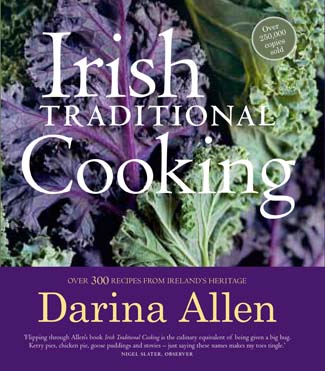 What is Irish cuisine – or is there any such a thing at all? There’s been a lot of talk about it in recent years and the idea has often been scornfully dismissed, as too has the concept of associating Ireland with good food at all - until recently at least.
What is Irish cuisine – or is there any such a thing at all? There’s been a lot of talk about it in recent years and the idea has often been scornfully dismissed, as too has the concept of associating Ireland with good food at all - until recently at least.
It’s true that the word ‘cuisine’ does not sit comfortably with the things we do best in Ireland but, as Irish food ambassadors like Darina Allen and her mother-in-law Myrtle have been saying for many decades now, we do have a great culinary heritage.
Based on the finest raw ingredients in the world (and getting better all the time as traditional farming methods are valued highly once again, and consumers demand more seasonal local produce), the Irish culinary tradition is essentially good home cooking, without frills or pretensions, and all the better for that. Coming from the land and seas around us, it suits our climate and is as much an expression of Irish culture as our music, literature or myths and legends.
As Colman Andrews said in the Introduction to his beautiful book The Country Cooking of Ireland (Chronicle Books, $50; with Foreword by Darina Allen), “There is a sense in which all Irish cooking – at least the good stuff, the real thing – is country cooking.” Darina Allen’s Irish Traditional Cooking (Gill & Macmillan, hardback, 336pp; €27.99) tells a similar story – vividly, and from a much more personal perspective – and, while it has been available for nearly twenty years now, this new extended edition with over 100 new recipes will introduce a fresh generation to the joy of preparing and eating simple traditional food with local connections.
Interspersed with historical background notes, little comments attached to recipes handed down for generations, and the occasional dish that’s just for the record (it’s unlikely anyone would cook roast thrush again, for example), the main body of this book covers appealing and very do-able recipes that are just right for today and also give us a fascinating insight into a gentler-paced everyday life that was so recently familiar.
Some recipes are a little nostalgic, and that suits the retro mood of the times (plenty of good bakes to serve on that mismatched china) and, as well as providing endless ideas for great everyday (and some high day) food to cook at home, there is plenty to interest professional cooks too.
Visitors to Ireland often complain about the international style of the food they are offered here – every chef should have a copy of Irish Traditional Cooking, and use it to death until it becomes dog-eared and spattered with the ingredients of many good meals.
There is food for thought here for every type of restaurant; pubs, especially, will find many, many good dishes that will charm customers and send them happy on their way – and, perhaps, with a refreshingly different view of Irish food.
And that is clearly what Darina herself would like the book to achieve: when asked to comment on the new edition she said, "I hope that Irish Traditional Cooking will encourage chefs to put at least one traditional Irish dish on the their menu every week and to serve Irish food proudly. It's an endless challenge for tourists to find a nice bowl of coddle or Irish stew and anything that sounds vaguely traditional - a definite opportunity for many restaurants, cafés and pubs and there's so much there."
RECIPES from Irish Traditional Cooking:
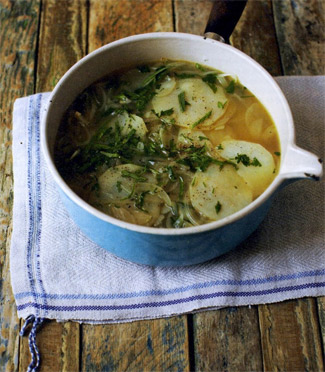 Potato, Onion and Lovage Soup
Potato, Onion and Lovage Soup
Lucy Madden from Hilton Park in Co. Monaghan, one of Ireland’s most charming country house hotels, made this delicious soup for me from the organically grown vegetables in her garden. [Lucy Madden is the author of ‘The Potato Year’, with a potato recipe for every day of the year. Although currently unavailable, a reprint is planned – contact her at Hilton Park (lucy@hiltonpark.ie) for an update.]
Serves 6
10–25g (½–1oz) butter
225g (8oz) onions, very thinly sliced
350g (12oz) potatoes, thinly sliced
salt and freshly ground pepper
1.2 litres (2 pints) good homemade
chicken or vegetable stock
a large handful of lovage leaves
Garnish
lovage and parsley
Melt the butter in a heavy-bottomed saucepan on a low heat, add the onions and potatoes, season with salt and freshly ground pepper and sweat until soft but not coloured.
Add the stock and boil for 5 minutes. Snip the lovage leaves into thin strips with scissors. Put 3 tablespoons into the soup and cook for a further 10 minutes.
Serve with a sprinkling of snipped lovage and a little chopped fresh parsley.
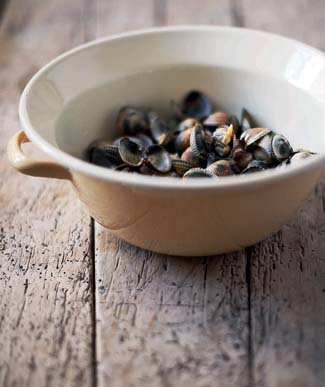 Cockles with Melted Butter
Cockles with Melted Butter
Cockles have formed part of the Irish diet since earliest times. Archaeological remains have been found at early historic sites such as Oughtymore, Co. Derry, Park Cave, Co. Antrim and Potters’ Cave, Co. Antrim.
Cockles formed the mainstay of the diet along the coastal regions during the great potato Famine of 1845. The Congested District Board Records also tell of how cockle gathering was widespread around Donegal on the eve of the Great Famine.
Wash the cockles in several changes of cold water to remove the sand and grit from the shells. put into a saucepan or frying pan, cover and cook over a medium heat. They open in just a few minutes and are best eaten straight from the shells, just dipped in melted butter.
Eat with loyts of crusty brown bread. The cockle liquid is also delicious. Cockles are also delectable with a bowl of homemade mayonnaise.
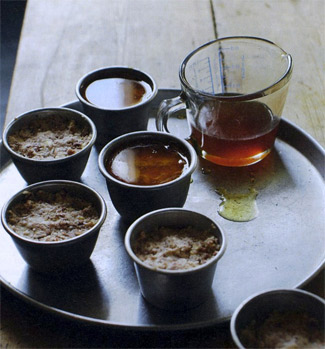 Potted Meats
Potted Meats
Tasty potted meats were another way of using up little scraps of the leftover Sunday joint. In the days of the pestle and mortar this was a labour-intensive business, but nowadays delicious potted meats and fish can be made in seconds using a food processor.
Spices were traditionally used for potted meat, but I also find some fresh herbs, for example parsley, chives and thyme leaves, can be a delicious addition. Chicken, ham, beef and game all make successful potted meats.
Serves 6
110g (4oz) cooked meat
30–50g (1–2oz) butter, cut into cubes
30g (1oz) jellied meat juices, if available
salt and freshly ground pepper
spices e.g. freshly ground nutmeg,
mace, allspice or juniper berries, depending on the meat
clarified butter
Remove any fat and gristle from the meat. Chop the meat finely and pound to a paste. Alternatively, put into a food processor and whizz for a few seconds.
Add the cubed butter, meat juices, salt, freshly ground pepper and spice. Whizz for a further few seconds, taste and add seasoning until you are happy with the flavour.
Pack the meat into little pots or ramekins and pour a layer of clarified butter over the top to exclude the air. These will keep for a week to 10 days in the fridge.
Serve with hot buttered toast.
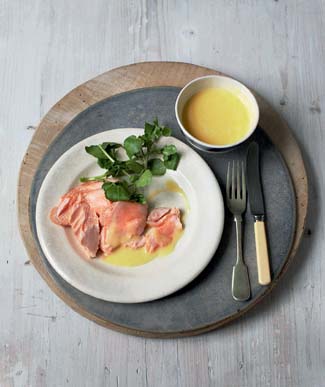 Poached Salmon with Irish Butter Sauce
Poached Salmon with Irish Butter Sauce
For maximum flavour, we cook the salmon in the time-honoured way, by poaching it gently in well-salted boiling water. Better still, use sea water if you are close to the coast.
Serves 8
1.1kg (2½lb) centre cut of fresh salmon
water
salt
Irish butter sauce:
2 egg yolks
1 dessertspoon cold water
110g (4oz) butter, diced
1 teaspoon approx. lemon juice
Garnish
sprigs of flat parsley or watercress
The proportion of salt to water is very important. We use one rounded tablespoon of salt to every 1.2 litres (40fl oz) of water. Although the fish or piece of fish should be just covered with water, the aim is to use the minimum amount of water to preserve the maximum flavour, so therefore one should use a saucepan that will fit the fish exactly. An oval cast-iron saucepan is usually perfect.
Half fill the pan with measured salted water and bring to the boil. Put in the piece of fish, just covering with water, and bring back to the boil. Simmer gently for 20 minutes.
Turn off the heat, allow the fish to sit in the water. Serve within 15–20 minutes.
Meanwhile make the Irish butter sauce. Put the egg yolks into a heavy-bottomed stainless-steel saucepan on a very low heat. Add the cold water and whisk thoroughly.
Add the butter bit by bit, whisking all the time. As soon as one piece melts, add the next. The mixture will gradually thicken, but if it shows signs of becoming too thick or ‘scrambling’ slightly, remove from the heat immediately and add a little cold water if necessary. Do not leave the pan or stop whisking until the sauce is made. Finally add the lemon juice to taste. Pour into a bowl and keep warm over hot, but not boiling, water.
To serve, lift the cooked salmon carefully from the poaching liquid. Peel off the skin gently. Garnish with sprigs of parsley or watercress. Serve with the Irish butter sauce.
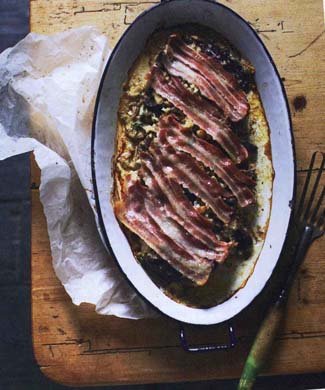 Baked Liver and Bacon
Baked Liver and Bacon
This dish was taught in the school cookery classes for many years, until the 1960s at least, and makes a very tasty supper dish. Here is Lily O’Reilly’s recipe from her 1940s notebook.
Serves 2–4
225g (8oz) sheep’s liver
4 streaky bacon rashers
175–225ml (6–8fl oz) homemade stock
Stuffing
2 tablespoons breadcrumbs
1 teaspoon chopped parsley
1 teaspoon chopped onion
pinch of mixed dried herbs
(fresh herbs may of course be substituted)
1 dessertspoon chopped suet (butter or margarine may be substituted)
salt and freshly ground pepper
stock or milk, to moisten
To make the stuffing, put the breadcrumbs, parsley, onion and herbs into a bowl. Add the suet, pepper and salt, and moisten with a little stock or milk.
Cut the liver into strips about 1cm (½in) thick, wash in cold water and dry. Place in a greased baking dish and place the stuffing over the top.
Remove the rind from the bacon, thin out with a knife and put on top of the stuffing. Pour on the stock, cover with a greased paper and bake in a moderate oven, 180ºC/350ºF/gas mark 4 for about 30 minutes.
When cooked, lift on to a hot dish and pour a little of the sauce around.
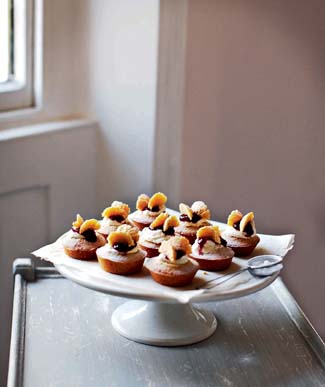 Butterfly Buns
Butterfly Buns
Pretty little buns like these are often the first recipe that children attempt and they are still as adorable as ever. First follow the recipe for Queen Cakes below (Darina includes this in a section on “Queen Cakes and Other Dainties”), then make them into butterfly buns.
Makes 12
110g (4oz) butter
110g (4oz) caster sugar
2 eggs, free-range if possible
vanilla extract, orange or lemon rind
140g (5oz) flour
¾ teaspoon baking powder
1 tablespoon milk or water
Cream the butter until really soft. Add the sugar and beat until white and creamy, either with your hand, as many of our ancestors did, or with a wooden spoon. Beat the eggs and flavouring and add gradually to the creamed butter and sugar.
Beat well. If preferred, the eggs may be broken and beaten into the mixture one at a time. A little sieved flour may be added between each addition of egg, if liked.
Stir in the remainder of the flour mixed with the baking powder, adding a little water or milk if necessary for a dropping consistency. Put the mixture in spoonfuls into well greased patty tins and bake for about 20 minutes at 200ºC/400ºF/gas mark 6–7.
Cool on a wire rack.
To make the Butterfly Buns: Cut the tops off each of the baked queen cakes. Cut these pieces in half and set aside. Put a little home-made raspberry jam and a blob of cream on to the bottom part of the cake.
Replace the 2 little pieces, arranging them like butterfly wings. Dredge with icing sugar.
Serve on a pretty plate.





There are currently no comments
Leave a comment
Not a member? Register for your free membership now!
Or leave a comment by logging in with: